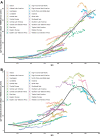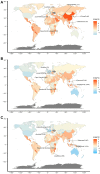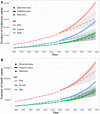Temporal Trends in the Disease Burden of Colorectal Cancer with Its Risk Factors at the Global and National Level from 1990 to 2019, and Projections Until 2044
- PMID: 36659904
- PMCID: PMC9842526
- DOI: 10.2147/CLEP.S388323
Temporal Trends in the Disease Burden of Colorectal Cancer with Its Risk Factors at the Global and National Level from 1990 to 2019, and Projections Until 2044
Abstract
Background: This study aimed to evaluate the global colorectal cancer(CRC) trend and the relevant risk factors from 1990 to 2019 and for better policymaking and resource allocation.
Methods: Data on CRC, including incidence, mortality and disability adjusted life year (DALY) rates, were extracted from the 2019 Global Burden of Disease (GBD) study. The estimated annual percentage changes (EAPCs) were calculated to assess the temporal trend of incidence, mortality and DALYs. The Bayesian age-period-cohort model(BAPC) was used to predict the future burden of CRC.
Results: In 2019, a total of 2.17 million CRC cases were reported worldwide, a 157% increase from 1990. In high-social demographic index (SDI) regions, the trend of age-standardized incidence rate(ASIR) tended to decrease, while the proportion of people under 50 years of age tended to increase. Although the number of deaths and DALYs increased, the age-standardized death rate (ASDR) and age-standardized DALY rate decreased. The CRC burden was growing fastest in middle-SDI regions, especially in East Asia, followed by low SDI regions. In addition, the milk intake, High-BMI and high fasting plasma glucose play a more important role in on CRC. The predicted cases and deaths in global continued to increase to 2044. And there is an upward trend in ASIR for both men and women.
Conclusion: In developed regions, the CRC burden continues to decrease, while the CRC burden become more and more severe in developing regions. Overall, the burden of CRC will rising in the near future. Therefore, reasonable resource allocation and prevention policies should be implemented. Developing countries needs more attention.
Keywords: Bayesian age-period-cohort; age-standardized incidence rate; colorectal cancer; disability-adjusted life year; estimated annual percentage change; global burden of disease.
© 2023 Liu et al.
Conflict of interest statement
The authors declare that they have no competing interests in this work.
Figures






References
LinkOut - more resources
Full Text Sources

